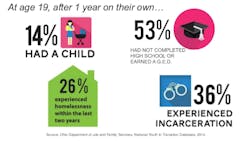Grant Me Hope has taken advertising to a new level by putting decals on the back of trailers, transforming the unused space into a moving billboard. This significantly increases the audience for their message: to learn about the reality of the foster care system in America and take action.
There are three decals to choose from: one informs that 600,000 children are in foster care, another states 25% of foster youth will become homeless adults and the third shares that there is little to no cost associated with adopting. The decals, designed by Zeerip Zeerip of Teddy's Transport, cost $18 each and are bought and paid for by the company that owns the trucks.
Zeerip’s executive assistant Annette Manwell explained why the decals are successful. In addition to expanding the audience and increasing the amount of time a person is exposed to the message, they also increase the odds of seeing the decal more than once.
“There have been studies on the fact that it takes seven to 10 times seeing something — the logo or the brand — before it clicks that you want to check it out and see what it is,” Manwell said. “The more we have on the backs of these trucks traveling everywhere, all kinds of people are going to see them, so it will only lead to good things.”
The idea for this mobile awareness campaign stemmed from a friend of Zeerip’s, who suggested she use her role as president of Teddy’s Transport to educate and advocate. Not only did she transform roughly 50 of Teddy’s trucks into moving billboards, but she also reached out to the owners of her competitors. Zeerip accomplished quite a feat — several purchased decals for their fleets.
USF Holland, Grassmid Transport and 4-WAY Transportation each bought 100 for their trucks, and Sweet Express had its own printing press and printed off 150 decals. Several other transit companies in the area followed suit, and now there are 850 decals on trailers traveling across the lower 48 states.
The decals each direct people to the Grant Me Hope website, which paints the picture of life for a foster youth, including what it’s like to age out of the system. Zeerip explained the process and also said that if there are not enough foster homes or orphanages available, these children are sent to institutions.
“These kids have done nothing wrong,” she said. “There’s a huge misconception in America today that the kids are juvenile delinquents, and they’re not. They are victims of circumstances way beyond their control.”
This includes parent death, arrest or neglect.
Female former foster youth are 75% more likely to rely on government services than their peers, and in 2012, 52% of former foster males were unemployed. Both male and female former foster youth are seven times more likely to develop drug dependence, and roughly 25% will commit a crime within four years of leaving the system.
Manwell said the children are not to blame.
“It’s not their fault—you can’t do any better than what you’re taught,” she said.
Zeerip agreed and explained that these negative repercussions results from a lack of proper guidance.
“You’re starting out with innocent children that want to be loved and have a home, and when that doesn’t happen these are the statistics you get,” she said.
About 25% of foster kids experience PTSD, a rate that’s twice as high as an American war veteran. Grant Me Hope focuses on the children that are the hardest to find homes for kids who are 10 or older, sibling groups, and those with medical conditions.
“If I save one kid, it’s worth all the work,” Zeerip said. “Just one.”
There’s been far more than one child adopted, mainly because of the efforts of Zeerip and her supporters.
Zeerip and her husband Craig have been foster parents for 14 years and adopted two children, but they were still unaware of the severity of the situation.
Zeerip said if she didn’t know, others likely didn’t either. And she only became aware of the dramatic statistics after watching an adoption training video in 2014. The child explained how much more difficult life becomes for a child who turns 18 without having been adopted—how fearing and reaching this milestone, a child can easily lose hope.
“It’s kind of how Grant Me Hope came about, because that little boy in the video said no one should steal your hope,” Zeerip shared.
But she felt compelled to do more, so she got permission from the state, and in January of 2015 began airing weekly videos of Michigan children who needed to be adopted.
Zeerip said that her first child received 19 calls from interested families. She soon recognized that this problem extended nationwide, and began to partner with stations in Ohio, fundraising to continue the videos.
In addition to fundraising, the TV videos are paid for through private grants; Zeerip does not receive any federal or state funding. She said she prefers it this way because she doesn’t have to deal with any bureaucracy or strings attached to the money, and she can work quicker on her own schedule.
Manwell says the videos are powerful because they humanize the issue.
“Everyone knows there’s foster kids out there, but it puts the face and the voice and the sweetness into it when you see a video,” Manwell said. “Suddenly they become real and they become human and they have faces and smiles.”
As the video campaign grew, Grant Me Hope’s website expanded to serve as a national platform for foster care adoption, and has a drop-down menu organized by state, with a link to adopt those specific children. Michigan foster children have “waiting since dates” and sadly, some have been in the system for close to a decade and are dangerously close to aging out of the system.
But Zeerip isn’t done yet — not only is she striving for more companies to purchase decals for their fleets, but she wants to run state-specific videos in every state. This year, she said, she’d like to add at least two more states: Indiana, West Virginia, Kentucky and Illinois are all in the works.
“So that’s what I’m doing in my spare time,” Zeerip said with a laugh.




